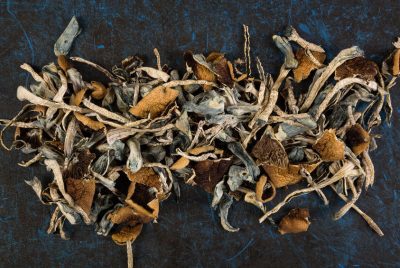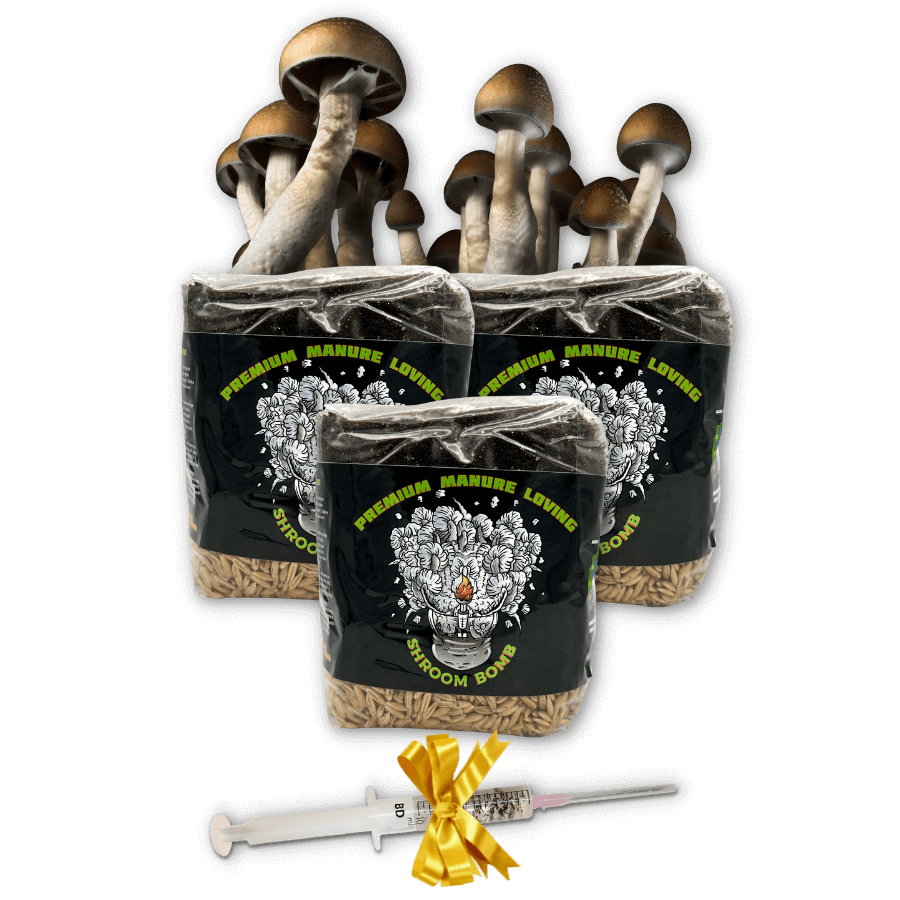There are over 180 types of magic mushrooms varieties all with different potency levels (some 12x…
Magic Mushroom Mycelium Bruising or Blue Green Mold on Mycelium

One of the most crucial aspects of mushroom cultivation is ensuring that your mycelium stays healthy; thus, you would want to easily spot mycelium bruising or contamination and tell whether any coloration is normal mycelium bruising or the most destructive blue-green mold on mycelium.
Trimming, fanning, and watering might be the critical components of successful growth. But none of these come close to the importance of keeping mold out.
One of the most intrusive molds you would want to keep an eye on and treat immediately is the blue-green mold from the Trichoderma genus.
Of 254 identified species of Trichoderma, the most commonly known are the Trichoderma harzianum, Trichoderma viride, and Trichoderma conidia. Several species of Trichoderma cause green mold disease in mushrooms.
Below, we will answer common questions regarding mycelium bruising or contamination:
- What is magic mushroom mycelium bruising, and what causes it?
- What is blue-green mold, and how does it affect mycelium?
- q-tip or cotton swab test
- the easiest way to spot Trichoderma contamination
- Trichoderma appearance under the microscope
- How to Prevent blue-green mold on mycelium?
- How to Stop blue-green mold on mycelium?
- Is it safe to eat mushrooms off of a cake with green mold?
1. What is magic mushroom mycelium bruising, and what causes it?

Magic mushroom blue bruising is mycelium’s blue or green coloration. It can occur when the mycelium is touched or pressed against the container. Coloration may also happen after the mycelium has been rehydrated, misted with, or dunked in water.
Blue bruising is a common feature of mushroom species containing psychoactive compounds such as psilocybin and psilocin. The most well-known type of psilocybin mushrooms that will exhibit mycelium bruising is the Psilocybe cubensis.
Other non-psychoactive mushrooms may also turn blue because they contain other bluing extracts, such as the compound gyrocyanin in Cornflower Bolete.
However, there is no precise info on whether the mycelium (other than the fruiting body, the mushroom) of such mushrooms may also exhibit blue bruising.
2. What is blue-green mold, and how does it affect mycelium?

Several species of Trichoderma, also known as green mold, frequently contaminates any mushroom substrates. It is the most persistent and aggressive mushroom contaminant.
Green mold, just like any other mold, usually begins growing on the mushroom mycelium as an off-white spec. Then, it matures into olive color to dark green.
This mold, which may sometimes have a blue-greenish tinge, can cause mushroom mycelium to look normally bruised.
But unlike normal bruising, green mold is fast-growing and will destroy your crop! From spores, molds grow and become noticeable within 24 hours!
A specific species called Trichoderma harzianum is the most common mold known to cause soft decay in mushrooms, like sour rot or wet spot bacteria contamination.
Aside from Trichoderma, the ideal growing condition for mushrooms also invites other types of molds like:
- Cobweb Mold (Hypomyces or Dactylium)
- Black mold (Stachybotrys)
- Orange-red bread mold (Neurospora)
- Black bread mold, a.k.a pin head mold (Rhizopus)

Trichoderma mycelia compete with mushroom mycelia for space and nutrients, causing reduced mushroom production.
Also known as green mold disease, Trichoderma symptoms include dense green sporulation on substrates, significantly reducing mushroom yield.
Further, Trichoderma produces various mycotoxins that retard mushroom mycelium growth and enzymes that break down fungal cell walls and contribute to mycoparasitic activity.
2.1 Determine blue-green mold mycelium contamination using Q-Tip or cotton swab test

To conduct a q-tip, gently swab the mycelium part where coloration is evident. If there’s color transfer to the cotton, your mushroom is probably contaminated.
However, this is still not an accurate test. Bruised mushroom mycelium that is too dry may show color transfer.
The more precise way to determine Trichoderma contamination is to view it under a microscope.

2.2 What is the easiest way to spot Trichoderma blue-green mold contamination?

Observe the growth the moment you spot a discoloration in your mycelium.
According to Paul Stamets, Trichoderma looks like:
“a cottony mold, growing in circular colonies on the casing soil or compost. Grayish and diffuse at first, rapidly growing, and soon forest green from spore production.“
3. How to Prevent (Trichoderma) blue-green mold on mycelium

When it comes to Trichoderma, one thing is for sure: it loves an acidic environment. Thus, to prevent it, you must keep the surface layer of your substrate alkaline at 8.0 to 10.0 pH.
A Reddit post by u/DayTripperonone under the r/ContamFam forum gives us valuable hints/tips to prevent mold contamination. Here are some key takeaways:
- Add a 1-inch loose casing layer around day 10 to 15 since inoculation. The best recipe would be 50% peat moss and 50% vermiculite or perlite.
- Before applying the casing layer, ensure its moisture DOES NOT exceed field capacity. To check for this, grab a handful of the casing layer and give it a tight squeeze; if a few steady drops of moisture come out, it is good.
- To stimulate pinning, allow fresh air into the growing room or monotub. Also, mushrooms need constant, high humidity (Relative Humidity (RH) between 80-90%) to develop properly.
4. How to Treat (Trichoderma) blue-green mold on mycelium
If you’re noticing blue or green mold on your mycelium, it’s essential to take action to stop the spread of the mold. Here are a few tips:
- Remove the affected mycelium, or the mushroom grow kit from the other batches. Isolate the affected area. This will help prevent the spread of the mold to healthy white mycelium.
- Raise the temperature. Mold likes cooler temperatures, so raising the temperature of your growing area can help discourage its growth.
- Improve air circulation. Mold needs moist conditions to grow, so improving air circulation will help keep the area drier and less hospitable for mold growth.
Other growers advise “burninating the contaminates,” killing the surface mold with fire.
In addition, Paul Stamets recommends the following:
Cover the infected area with “…salt, sodium hypochlorite, sodium bicarbonate (baking soda), or a solution thereof.”
Again, Trichoderma has trouble thriving in an alkaline environment. This treatment will raise the pH level of the substrate, preventing further mold growth.
If you can recognize and treat any molds’ early stages before many spores are produced, you will significantly reduce the risk of satellite colonies spreading throughout the substrate bed.
Satellite colonies are tiny colonies that have not taken up the plasmid (small circular DNA molecule found in microorganisms such as mold); they form around a large colony that has taken up plasmid."
5. Is it safe to eat mushrooms off of a cake with green mold?

If the mushroom itself has molds, you surely should NOT consume it. Also, saving a contaminated mushroom cake does not automatically mean saving it to make it edible. Well, some people try to save contaminated cakes just for experiments.
But what if the mold is just on the mycelium and not mushrooms?
Some users from online forums say that they have consumed mushrooms off of a moldy cake, and they turned out fine. In contrast, some users think that it’s not worth the risk.
However, note that when the mycelium has molds, it has probably already spread mold spores to the mushrooms.
Exposure to mold spores can cause various illnesses.
It may cause sneezing, coughing, sore throat, irritation and inflammation of the airways, and asthma attacks. Mold spores can also cause lung infections, such as pneumonia.
Consuming mushrooms from contaminated mycelium may NOT be WORTH endangering your health.
Key Takeaways
- Mycelium may also bruise blue as it contains traces of active substances.
- Mycelium bruising is dark blue or blue-green and usually occurs when the mycelium is pressed or rehydrated.
- Trichoderma mold starts as a thick off-white growth and quickly develops into an emerald green color with a distinct bright white ring surrounding the colony.
- Conduct a q-tip test. If there’s color transfer, it’s probably Trichoderma contamination.
- To prevent Trichoderma contamination, use a 50-50 peat moss and vermiculite casing layer and maintain a ~9 pH level of the substrate.
- To treat Trichoderma contamination, spread a solution of either salt, sodium hypochlorite, or sodium bicarbonate.
- Lastly, consuming a moldy mushroom or a mushroom off of moldy mycelium is dangerous.








[…] fastest and strongest solution to get rid of the green mold spores is mixing laundry bleach, water, and […]
thanks for all info, big help
It’s our pleasure, Richard.
-Jess from Customer Support team